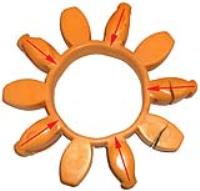 Add My Company
Add My Company
Sign In
Spider Issues Part I: Overload
16-01-2019

Overload Wear
The rudimentary design, ability to weather harsh environments and cost-effectiveness of jaw couplings make them an ideal choice for rotational power transmission. However, much like any mechanical component, couplings will not function perfectly 100% of the time. Since the health of any jaw coupling design relies heavily on proper spider function, we decided to create a series to explain some of the most common spider failure issues, the first of which is spider overload.
Regular Spider Wear
Now, before we get into spider overload, it’s important to be able to differentiate normal wear from a more significant issue. Assuming a favourable operating environment, for jaw-type couplings that operate in one direction, there should be even wear on every other spider lug. Additionally, for couplings that operate in two directions, the wear will be present on all spider lugs as half will be under compression in one direction of rotation and half in the other direction.
Although regular operation will result in coupling wear, it’s critical not to allow the wear to become too extreme. When it comes to coupling maintenance, it’s best to replace spider lugs when wear reaches the recommended permissible limit – ROTEX wear values can be found in our operating & assembly instructions…
https://www.ktr.com/fileadmin/ktr/media/Manuals/40210en000000.pdf
When one lug reaches the acceptable wear limit then spider should be replaced, in order to avoid systemic problems. Unfortunately, given the diversity among coupling applications, any guide to wear is just that… a guide. Environmental and operating factors such as misalignment, vibration, temperature, and repetitive stops and starts will all affect the lifespan of a coupling. Therefore, it’s important to visibly inspect couplings as part of routine maintenance to ensure the spider lugs have not been overly worn down.
It is also worth noting that some couplings are fail-safe by design, which means that they will continue to operate even after failure. For instance, with jaw type couplings, as when spider elements fail due to extreme wear or overload, the metallic jaws of the hubs interconnect and take over the transmission of torque. This is a critical feature of the coupling design when considering the need for a pump on a fire engine to continue to operate even in spider failure situations. Of course, this is not a sustainable long-term mode of operation, as the continual metal on metal operation will eventually wear down or break the hubs and can quite quickly result in the complete coupling failure. The root of the problem should be identified straightway, and fortunately, coupling failures, such as spider overload, can be visibly identified.
Overload Wear
When couplings are forced to accommodate peak torque loads that exceed their allowances, overload stresses will occur. This can be due to a systemic error but is more commonly associated with incorrect selections and undersized couplings. When systems operate with couplings that do not have the necessary torque allowance, the coupling is forced to operate beyond its limits. In very extreme cases the metal jaws of the hubs can be outright destroyed but the elastomer spider is typically the first victim of the excessive force. When this happens, you’ll often see uneven, sheared or shaved down spider lugs, rather than the even wear consistent with a more properly aligned operation.
However, one of the most apparent signs that overload exists is the shape of the spider itself. This is due to the curved design of the hub jaws forcing the alternate spider lugs to the centre of the coupling, creating a square shape or form (see images below). If this is the case, the element will need to be replaced and a closer look at the coupling selection and the system setup should be undertaken. Unfortunately, when undersized couplings experience overload failure, a new coupling may be required rather than a simple spider replacement, as the same failure will continue to occur unless a coupling with a larger torque allowance is installed.
However, the first thing to check is whether the required performance can be achieved by using an elastomer with an increased shore hardness. This would be the easiest solution to the problem. But be aware that increasing spider shore hardness comes with a trade off of decreased vibration dampening properties of the coupling, as well as reduced capability to accommodate radial and angular misalignment.
Although many issues can be avoided by selecting the proper coupling initially, problems can still occur. It’s useful to be able to spot and identify problems in order to mitigate the complications of system errors.
For more information on Spider Issues Part I: Overload talk to KTR U.K. Ltd
Enquire Now
List your company on FindTheNeedle.

